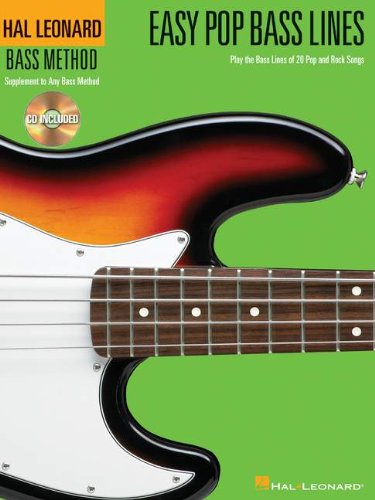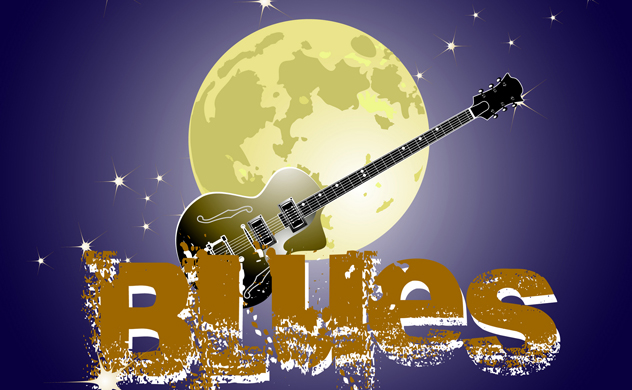
Play the Bass Lines of 20 Pop and Rock Songs (Bass Method)
This songbook is a great resource for beginning bass players. It includes your favorite hits from The Beatles, Nirvana, Stevie Ray Vaughan, Garth Brooks, Eric Clapton and more.

As a guitar instructor for students ranging from beginners to pros, I have to adapt the guitar lessons to each guitar student’s skill level and their dreams. Some guitar students want to be the next Eric Clapton or B.B. King. Others want to emulate Ottmar Liebert or Chet Atkins. The wonder of the guitar is that it can do it all.
Recently I was giving guitar lessons to two East Bay guitar students (1 in Livermore, the other in Walnut Creek CA) with different skill levels and different stylistic needs – both wanted to play the blues.
Beginner bass guitar player, Mike in Walnut Creek has been studying guitar with me for a year and really struggled with the 6-string guitar. After 6 months he switched to bass guitar. He figured two less strings on a 4-string Fender Precision Electric 4 string bass might be easier for him.
I have him working with my series of easy to play bass guitar grooves that are based on a 1 measure pattern known as a box pattern. This means a pattern played in one position ( 4 fret span ) and then used in 12 bar blues format. These will be known as Bass Patterns 1, 2 and 3 with standard notation as well as tab and even sound wav.
Mike is tired of just practicing & reading music. He’s champing at the bit to go jam. So I told him to just get down 12 bass patterns and then you will be ready once you learn how tom play in any key. This the first of 4 groups of lessons for beginner bassists that want to start jamming. Remember , less is more. Keep your patterns very simple.
Heads will turn when you use this finger pinching blues pattern a la Chet Atkins. Most guitarist when playing rhythm blues guitar patterns stick to the traditional patterns like from songs like “Kansas City” or “Johnny B Goode” by the great Chuck Berry. Don, an excellent guitar student in Livermore CA, has been playing serious guitar for over 25 years. He said he was in a typical mental block when jamming at local clubs in Contra Costa County and Solano County.
He found himself always resorts to same rhythm guitar patterns. This blues guitar pattern What I taught Don and what I’m teaching you today incorporates your right hand pinching strings 6,4 and 3 using a pick or straight all fingers. I have made it easy for all levels with correct fingerings and practice slowly in 2 bar phrases. Once you have mastered this every beat pattern, use it along with traditional rhythm blues patterns and you will receive a lot of positive comments from other musicians. I have included an mp3 with traditional piano because it is easier to hear the clear groove.
Questions & inquiries always appreciated.

Today I was teaching a Bass Guitar student in Danville how to read music with use of color coded flash cards. My beginning bass student has been reading music using Hal Leonard Bass Method Book 1 with CD. In the past, he had been writing the name of the note above each note on the staff and never learning how to actually read standard music notation. He was getting very frustrated as he was not seeing any progress in learning to read music. So, I recommended to make life simple and put the bass down and practice with music flash cards for bass clef.
The flash cards covers clefs, time signatures, notes, rests, melodic and harmonic intervals and key signatures. In one week my student was reading standard music for bass clef without the aid of pencil markings above each note. Building guitar and bass guitar confidence is what guitar confidence.com is all about.
Please leave us a comment with your story or music challenge and we will address it in a future blog post.

I was giving a guitar lesson to one of my bass guitar students from San Ramon who has been reading Hal Leonard’s Bass Method Book I. He had not been practicing his reading assignments regularly for two months because he was rehearsing a 35 song playlist for a paying gig and only had so much time for practicing.
So today, we were back to the work on reading music for bass guitar. Bass guitar uses the bass clef as compared with regular guitar that uses the treble clef. We started where we left off two months ago on techniques taught to music majors at the college level where you practice sight reading daily.
Before you play a new exercise for the first time, make sure you speak it out loud without out picking up the guitar and say each note from left to right. You should say the name of the note and the fret location. For example, on a 4 string bass if the note was string 4 fret 1 you would simply say F1. This programs your built in computer that God gave you known as your brain to remember the note locations on the fretboard.
THEN SLOWLY AT ABOUT 75 B.P.M. on the metronome tap your right foot, if your right handed, or left foot if left handed and count out loud 1,2,3, and 4 and try to play the exercise without stopping. Try not to keep looking at your fret board and hand but keep your eyes on the music so you don’t get lost. If you are still not making it through the exercise without making lots of mistakes, try naming each note out loud as you play instead of counting each beat and just say the name of the note and not the fret location. More to come.
To get started with learning to read sheet music for guitar, I highly recommend Hal Leonard Method Books.
Guitar Confidence
4101 Dublin Blvd
Suite F, #537
Dublin, CA 94568
